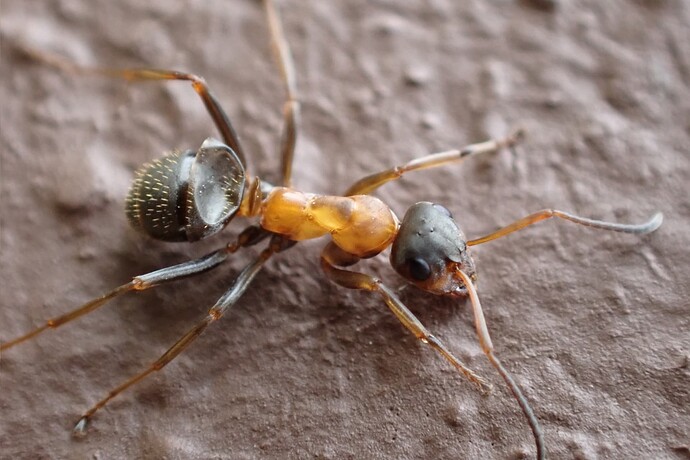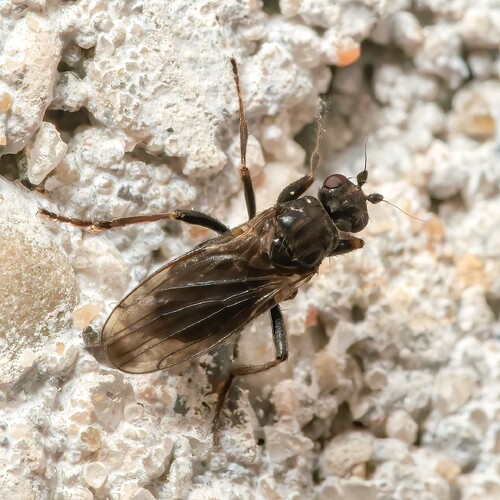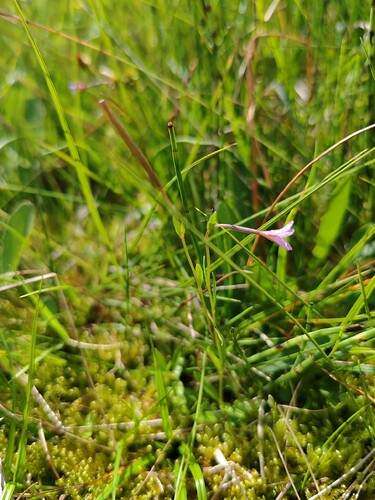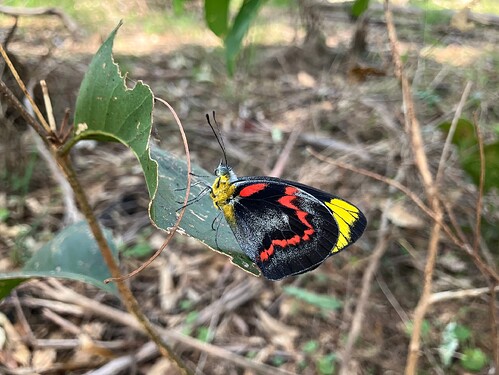I found my first scale insect this week!
I thought that it looked like a scale insect almost immediately, but I wasn’t completely sure until I got back and uploaded the observation.
https://www.inaturalist.org/observations/265340992
A Red-barbed Ant: https://www.inaturalist.org/observations/265390136
A Common Cryptops - https://www.inaturalist.org/observations/265293543
Probably my best less-observed-lifers-on-inat spotted and photographed this week :)
Lesser favourite? Actually, any new lifer this early is a favourite. This week it was this Lesser Dung Fly from the genus Copromyza that I spotted on a park building wall.
https://www.inaturalist.org/observations/265039392
My only lifer in the past 7 days.
Hey, that looks like my cousin Verne!
what?
bROACHer joke.
(Guess it fell a little blatt.)
I see that you’re in Yucatan (please excuse my envy drool here). There are 8 species of walking sticks observed there. Do you think it might have been one of those that just crashed into the water?
Not at all, this was absolutely legless and besides it swam perfectly and for a long while and a long distance before being caught by the fish, so it is definitely marine and has nothing to do with an insect. It seemed to use it’s club-like head as a counterweight to swim. It was brown and its overall appearance was like that of a match, and at first I thought it was a blade of manatee grass.
It was very close to where the lagoon meets the sea, by the way. In that place there are also lots of shrimp.
And, surprisingly, when the fish caught it, it seemed to curl after being perfectly straight for all this time, but I couldn’t see well because water was blurry and murky.
Not observed this week, but Identified this week.
Epilobium nutans:
Eplibium nutans is a very rare species of willowherb in Slovenia, with less than 10 recent confirmed localities, only at most 2 of which are outside the silicate Alps region (Pohorje).
At this particular locality (Malo Polje on Velo Polje (Little field on the Big field, yes the names are very original)) in the limestone Julian Alps, this species was first recorded in 19th century, when this site was still a raised bog or trasitional mire (both generally acidic type of peat forming wetlands) with other very intersting plants (eg. Betula nana and Botrychium simplex and Sphagnum mosses); but it collapsed by the end of the century and only remnants of the vegetation remain, Betula and Sphagnum went extinct and so was persumed Botrychium, but Epilobium continued to be recorded and collected by botanists until recently.
Malo polje was also for a very long time the only known site of this species in Slovenia, and the sites on Pohorje were also only found during this revision.
Then a couple of years ago a revision was done on all the Epilobium species in Slovenia; and it was discovered all Epilobium “nutans” collections from Malo Polje were actually the dwarf peatland form of commoner E. palustre, and because the search of the species on the site yielded no E. nutans, only E. palustre, it was assumed (very justifiably) E. nutans never grew there or was at least not collected there (I think the leading theory was that the first person might have actually found true E. nutans before the mire collapse, but it probably went extinct with other mire species, like Betula nana and Botrichyum simplex).
Then, in 2018, i think, Botrichyium simplex was found on the site after 60 years of persumed extiction on a very small oligotrophic remnant of the mire.
I went last year on the site to check on that species (not found, unfortunately, but since Botrichyum can be mycotrophic, not surpirising; also probably the reson it was not found for decades) I found a little Epilobium in acidic mire remnant. Since the area was well researched and recently visited by other botanists, i just took pictured and I assumed it was the common E. palustre dwarf form. however, when I checked at home, things were not adding up, and I reconsidered the ID into a third species (anagallidifolium).
the last step in this saga was when other botanists discovered E. nutans in another peatland site in Julian Alps, which finaly prompted me to contact and ask the person who did the revision what she thought - and while it is hard to be 100% sure from the pictures, it sure does look like nutans!
So although this oldest site of this species in Slovenia was based on wrong determination of E. palustre, it turns out, the true E. nutans is also actually present, but it’s probably much rarer (there is plenty of herbarium material from this site that is all E. palustre) and I would have probably missed it had I not been looking for an even more diminuitive Botrichyum :)
i think the population is very small, maybe 10-20 individuals, probably occupying less than 5x5 m square of wetland…
Up to now I haven’t counted plants as lifers, because there are a lot that I know, that I have just never bothered to take a photo of. But currently is raining constantly and to keep up my streak I have to go out every day and find something. And I swear I have never seen this cute plant before: Tripodion tetraphyllum
My favorite lifer that I managed to list this week is this little moth from Colombia. Maybe it is Psaliodes crassinota, maybe it isn’t. It matched fairly well with the example presented in Polillas de Colombia, Guia de Campo by Rodrigo Bernal and Blanca Martinez (2023). It does not, however, match at all with any of the other individuals for the species listed in iNaturalist. From my view, my contribution marks the fourth distinct species of Psaliodes now list as P. crassinota on this app. I’ve no idea which one is correct but it does illustrate how futile it can be trying to identify small moths from remote places when the only available resources are fuzzy photos of 30-year old dried specimens.
I feel the grip of winter loosening this week, and I think that the animals around me do too. I’ve managed to get some early spring bug finds, most of which are commoner species. But this one was a lifer for me:
https://www.inaturalist.org/observations/265622978
A common bronzewing (Phaps chalcoptera)
There were a lot of butterfly fluttering around and not waiting to be photographed, and then this black jezebel (Delias nigrina) rested on a leaf and let me come close (I can now erase all the pictures I took as I stepped closer)
Could you please provide an observation for the butterfly? (Since it’s awesome!)
Where did you see this?
I am not Marie but the Observation is here. It is gorgeous!
Also this…
… made me laugh because slowly creeping while taking multiple approaching photos of butterflies while trying not to breathe is 100% my process.
Australia then, I suspected so because of the bronzewing.
I learned recently that bronzewings are one of the few birds that can sequester toxins in their tissues (the most well-known example is the hooded pitohui). They are thought to get it from their diet and it turns them toxic to any predators that would try to eat them (though it doesn’t appear very clear from the literature what the toxin is or what part of their diet it comes from).
I saw both at the The Australian Botanic Garden, Mount Annan. I updated my post to include the link to both observations.







